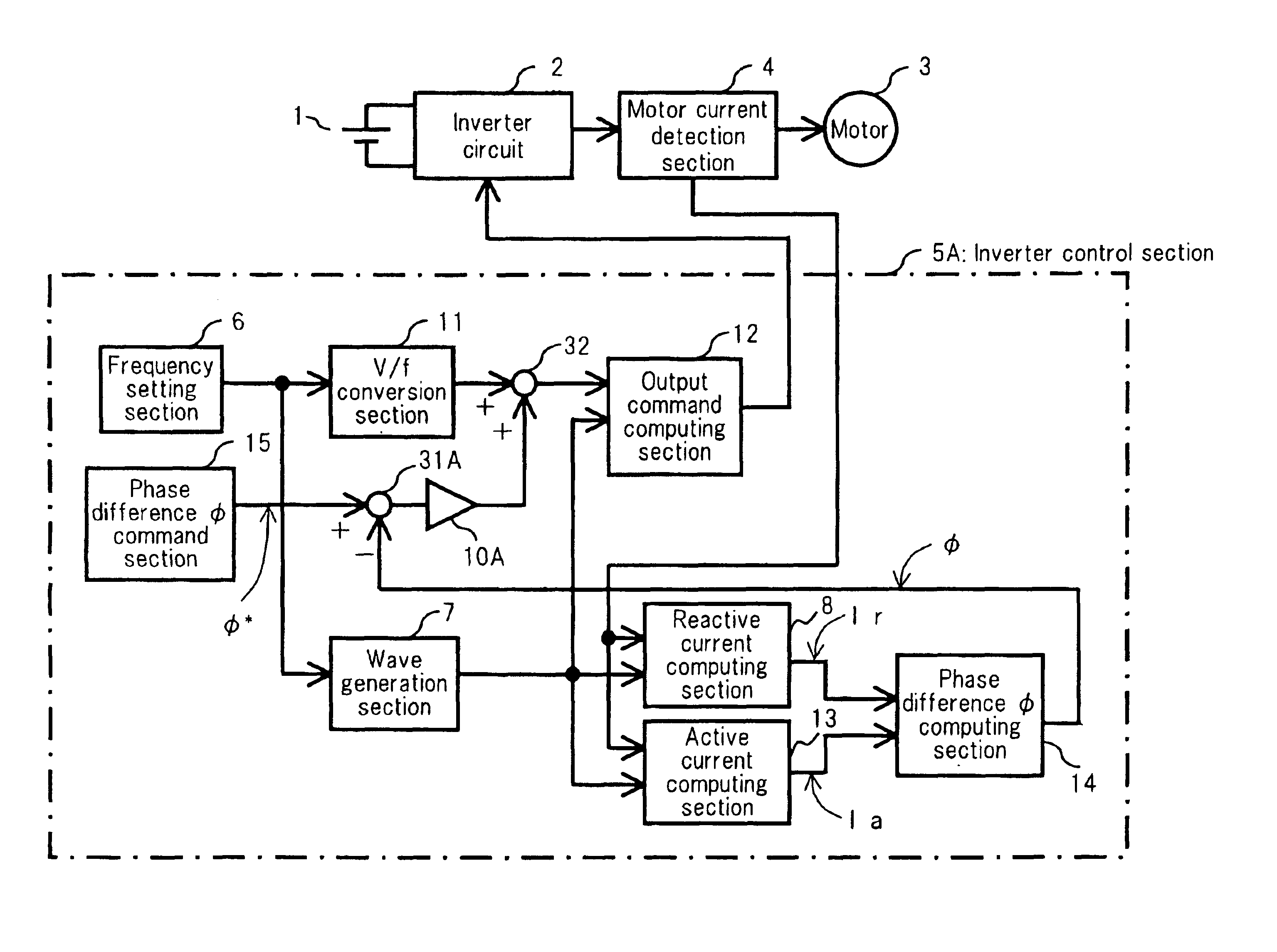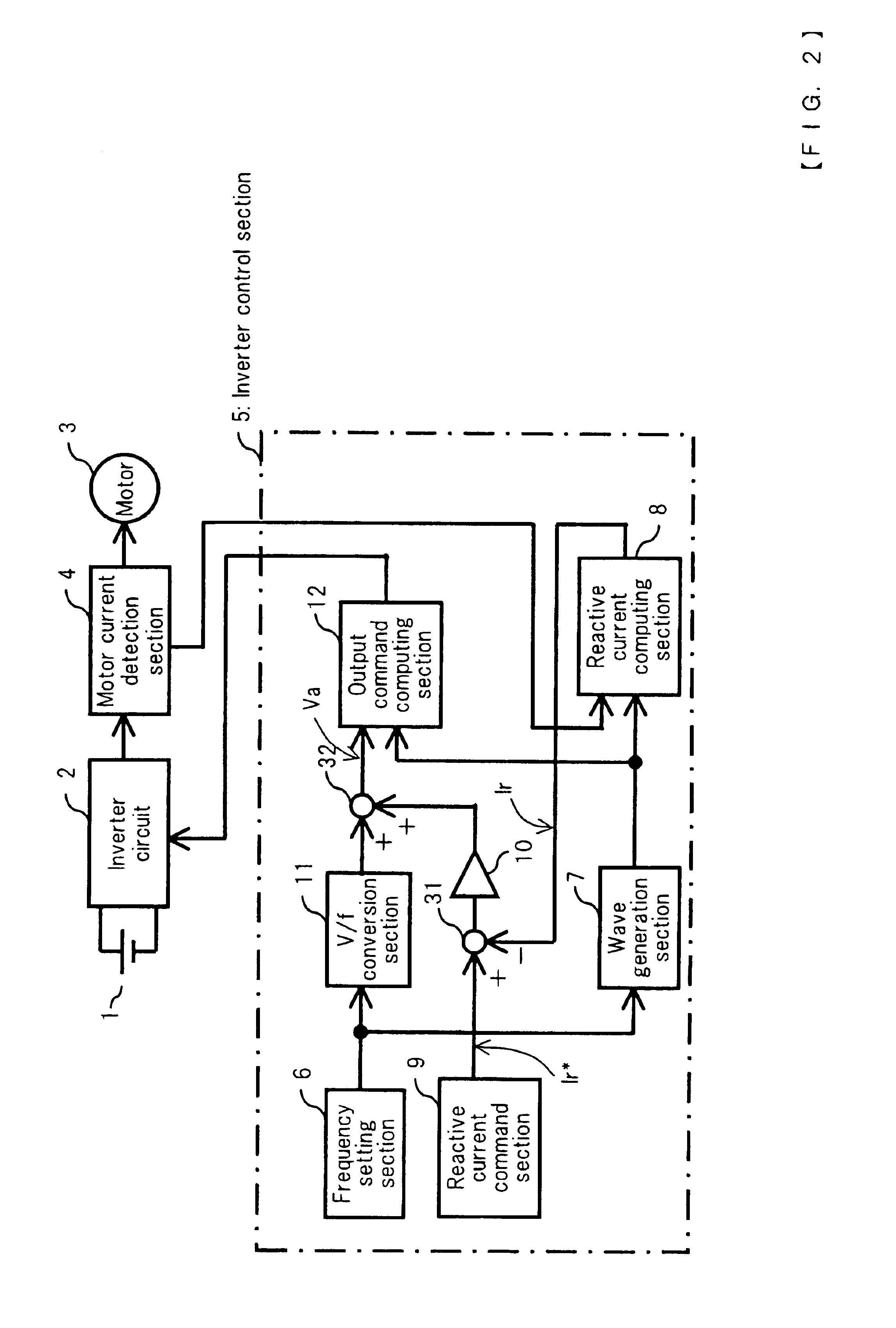Electric motor controller
a technology of motor controller and motor rotation, which is applied in the direction of electronic commutators, dc motor speed/torque control, electric motor speed/torque regulation, etc., can solve the problems of loss of synchronization, large detection delay owing to sample holding, and inferior sine wave driving method in all motor vibration and noise, so as to achieve stable control of motor rotation, low noise, and high efficiency
- Summary
- Abstract
- Description
- Claims
- Application Information
AI Technical Summary
Benefits of technology
Problems solved by technology
Method used
Image
Examples
first embodiment
FIG. 1 is a block diagram showing a basic configuration of a motor controller in accordance with a first embodiment of the present invention. Referring to FIG. 1, the direct current of a DC power source 1 is applied to an inverter circuit 2 and converted into an alternating current. The alternating current is supplied to a motor 3 via a motor current detection section 4. The motor 3 is a synchronous brushless motor, for example, and not provided with position sensors for detecting the position of its rotor. The output of the motor current detection section 4 is input to a detection section 57 having a reactive current computing section 54. The detection section 57 is included in an inverter control section 55. The detection section 57 computes a reactive current and outputs a detected value on the basis of the value of the reactive current to a computing section 58. Various set values to control the inverter circuit 2 are set in a setting section 56, and these will be detailed later...
second embodiment
FIG. 4 is a block diagram showing a motor controller in accordance with a second embodiment of the present invention. In FIG. 4, an inverter control section 5A is obtained by adding an active current computing section 13 and a phase difference ø computing section 14 to the inverter control section 5 in the first embodiment shown in FIG. 2, and by replacing the reactive current command section 9 of the inverter control section 5 with a phase difference ø computing section 15. In the other configurations, the motor controller in the second embodiment is the same as that in the first embodiment. The phase difference ø is the phase difference between the applied voltage command value Va and the motor current Is. The active current computing section 13 obtains an active current Ia from the computation of Equation (4). Ia=23×{Iu×sin θ+Iv×sin(θ-23π)+Iw×sin(θ-43π)}(4)
The active current Ia obtained from the computation of Equation (4) is a component of the motor current Is in a directi...
third embodiment
FIG. 5 is a block diagram showing a motor controller in accordance with a third embodiment of the present invention. In FIG. 5, an inverter control section 5B is obtained by replacing the phase difference ø computing section 14 of the inverter control section 5A in the second embodiment shown in FIG. 4 with a phase difference α computing section 16 and by replacing the phase difference ø command section 15 of the inverter control section 5A with a phase difference α command section 17. The phase difference α computing section 16 computes a phase difference α from the output of the reactive current computing section 8, the output of the active current computing section 13 and a motor applied voltage command value, i.e., the output of the adder 32, by Equation (7). α=Tan-1(R×IrVa-R×Ia)(7)
“R” in Equation (7) represents the resistance of a winding of one phase of the motor 3. The phase difference α indicated by an angle is the phase difference between the applied voltage command value ...
PUM
 Login to View More
Login to View More Abstract
Description
Claims
Application Information
 Login to View More
Login to View More - R&D
- Intellectual Property
- Life Sciences
- Materials
- Tech Scout
- Unparalleled Data Quality
- Higher Quality Content
- 60% Fewer Hallucinations
Browse by: Latest US Patents, China's latest patents, Technical Efficacy Thesaurus, Application Domain, Technology Topic, Popular Technical Reports.
© 2025 PatSnap. All rights reserved.Legal|Privacy policy|Modern Slavery Act Transparency Statement|Sitemap|About US| Contact US: help@patsnap.com



